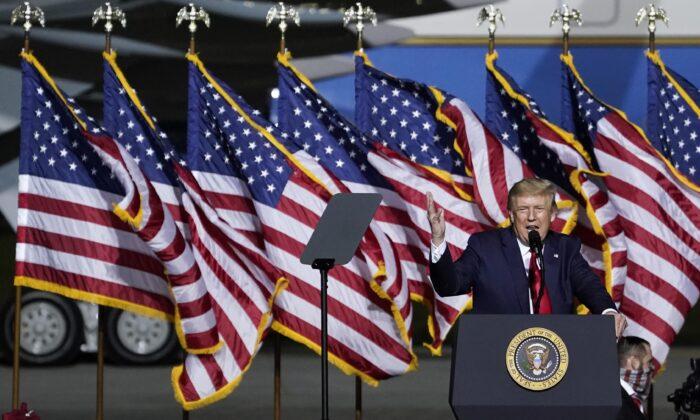The theories are based on the Marxist concept of “struggle,” pitting races and sexes against each other by labeling them “oppressors” and the “oppressed.” It then reinterprets society and history as being rooted in this “struggle.”
The theories have become the preferred creed of progressive intellectuals and have spread throughout academia, government institutions, public education, and the corporate world.
Employee trainings promulgating such “divisive concepts” lead to “race and sex stereotyping and scapegoating” and “have no place in programs and activities supported by Federal taxpayer dollars,” Trump’s order reads.
“All of this is contrary to the fundamental premises underpinning our Republic: that all individuals are created equal and should be allowed an equal opportunity under the law to pursue happiness and prosper based on individual merit.”
Critical race and gender theories, as understood today, emerged from progressive activism and academia in the 1990s by reimagining concepts of postmodernism and Marxism. Despite clashing with both conservative and classical liberal values, the theories gave birth to a burgeoning industry of consultants and speakers who get hired by corporations and government agencies around the country to train their employees on themes such as “implicit bias” and “white privilege.”
The trainings are supposed to promote “diversity and inclusion,” but research indicates they either have no effect on race relations or make them worse. The theories, however, include aggressive argumentation against criticism. Anybody reluctant to accept the ideology is accused of “white fragility,” racism, “internalized racism,” misogyny, and so on.
Training based on the theories can “use subtle coercive pressure to ensure conformity of viewpoint,” Trump’s order says.
Trump’s inclusion of contractors, subcontractors, and grantees into the order dramatically expands its effect.
The order was praised by opponents of critical theory and denounced by its supporters.
From Text to Practice
Proponents of the theories can stifle the order by “placing their people into administrative roles and twisting language/meanings,” he said.The administration will have to find “highly competent” people “who can sift through the shifting, jargon-laden terminology with the ability to spot Critical Theory even when it’s hiding itself,” he said.
“It’s like having landed and taken the beach on D-Day. Lots more to do.”
Then there’s the bureaucratic hurdle.
The contractor side of the order only grows its teeth when translated into a Federal Acquisition Regulation (FAR) clause, said Christoph Mlinarchik, government contracts expert and author of “Government Contracts in Plain English.” Contracting officers then include the clause into federal contracts that will become binding for the contractors upon signature.
“The process of creating these FAR clauses (called ‘rulemaking’ or ‘promulgating regulations’) takes months or even years from the signature of laws or EOs, due to requirements for public notice and comment, as well as internal agency deliberations,” he told The Epoch Times via email.
“I personally participated in this process to create FAR clauses when I worked for an earlier Pentagon client, and each day, I scanned a list that included overdue FAR cases from years ago.”
However, there is a way to dodge the lengthy process.
The head of each federal agency has the seldom-used power to issue FAR “deviations” that create a new clause “in a matter of hours,” Mlinarchik said.
The Trump administration may use this method, given the upcoming elections, he said.
The Subcontractor Universe
One of the most important pieces is the order’s explicit language extending the rules to subcontractors. While hundreds of thousands of companies register for federal contracts, only a fraction of major corporations, such as Boeing and Raytheon, actually go through the trouble of signing them, given the administrative burden of compliance.Federal subcontractors, on the other hand, represent a “gigantic” industry, Mlinarchik said. Only a portion of FAR clauses apply to subcontractors, making the job easier for them.
Based on the order’s language, the resulting FAR clause “will likely have explicit language directing the prime contractor to include the same clause in any and all subcontracts,” he said.
While the minutiae of the implementation remain unclear, the order has already made waves.
“Government prime contractors and subcontractors are most definitely taking President Trump’s EO seriously, because I’ve noticed a surge of discussions, questions, and concerns about compliance, both from my own clients and from my fellow consulting or attorney colleagues,” Mlinarchik said.
Beyond Government
The order also asks the attorney general to “continue to assess” whether critical theory trainings contribute to a “hostile work environment.” The language carries significant legal weight because hostile work environment allegations can be used by employees to bring workplace discrimination lawsuits under the Title VII of the Civil Rights Act of 1964.If the attorney general were to conclude that critical theory trainings indeed violate the statute, the mere risk of liability could spell the end of such trainings writ large.
Another part of the order says that no federal grant money should be used on critical theory trainings. However, it leaves it to the agency heads to decide on which grant programs the rules will be imposed.
The effect could be particularly strong on universities, which commonly accept federal grants while having their operations increasingly infused with critical theory.





